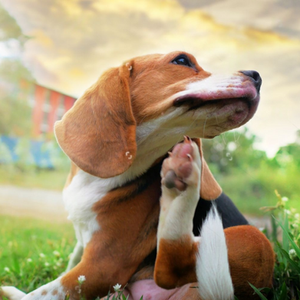Paws & Planks: Fitness Tips for a Gut That Wags Back Celebrating Canine Fitness Month with Gut-Smart Fun
- Emanuela Visone
- Apr 5
- 3 min read

As spring bursts into bloom, there’s no better time to get moving—with your pup by your side! April is Canine Fitness Month, a celebration of all things
tail-wagging, trail-blazing, and tummy-happy. At DogIBS.com, we’re passionate about helping dogs thrive from the inside out, and that means shining a light on a powerful truth: gut health and fitness go paw-in-paw.
Whether your dog suffers from occasional tummy troubles or you're just aiming to keep their digestion in tip-top shape, consistent physical activity plays a crucial role. So, leash up and get ready to learn how movement can be medicine for your dog’s gut—and how to make it fun for both of you.
The Gut-Fitness Connection: Why Movement Matters
You already know exercise is great for your dog’s heart, joints, and mood—but what about their digestion?
Turns out, physical activity is a natural digestive aid. Just like in humans, movement in dogs:
Stimulates intestinal motility (that means keeping things moving and preventing constipation or sluggish digestion)
Supports microbiome, encouraging a diverse population of healthy gut bacteria
Reduces stress, a major trigger for gut issues like IBS, IBD, or even food sensitivities
Boosts circulation, helping nutrients get where they need to go for cellular repair and immune balance
When a dog is sedentary or stressed, their gut can pay the price. That’s why even mild, consistent activity can be a game-changer for digestive health.
Spring Fitness Ideas for a Happy Gut and a Happy Pup
It’s time to get creative—and joyful! Spring is ideal for establishing new habits that stick. Here are a few fun, gut-smart ways to get your dog moving this month:

1. Outdoor Fetch with a Twist
Upgrade your daily fetch by adding gentle sprints or changes in direction to work their core and improve agility. Use gut-friendly training treats as rewards that support—not sabotage—their sensitive tummy.

2. DIY Agility Course
Set up a simple agility course in your backyard or at the park using cones, tunnels, or hula hoops. These exercises engage the body and mind, promoting relaxation and a healthier gut-brain connection.

3. Swimming for Sensitive Stomach
If your dog loves the water, swimming is a fantastic, low-impact workout that supports joint health and gently stimulates digestion. Just make sure to wait at least 30–60 minutes after a meal before diving in!

4. Indoor Movement Games
Rainy day? No problem. Hide treats around the house for a gut-stimulating sniff-and-seek game, or try a mini yoga session with your dog (yes, doga is real!). Gentle stretching can reduce cortisol—a stress hormone that disrupts digestion.
Gut-Smart Fitness Tips: Move with Intention
To maximize the gut-healing benefits of movement, keep these simple but effective strategies in mind:
1. Warm Up First
Jumping right into intense activity can stress your dog’s system. Start with 5–10 minutes of light walking or sniffing to gently activate the muscles and GI tract.
2. Time It Right
Exercise right after a big meal can lead to indigestion or even bloat in some breeds. Wait 45 minutes to 1 hour post-meal before heading out for a walk or playtime.
3. Hydrate Often
Water is crucial for digestion, especially when exercising. Bring a collapsible water bowl on outings and encourage your dog to sip regularly.
4. Know Your Dog’s Limits
If your pup has existing GI issues, start slowing and build endurance gradually. Signs of overexertion—like excessive panting, drooling, or sluggishness—can also signal digestive stress.
5. Cool Down + Rest
After exercise, let your dog wind down with a slow stroll or quiet sniffing session. Recovery time allows the gut to resume its natural rhythm.
Start a Gut-Loving Fitness Routine This Spring
Canine Fitness Month isn’t just about running, jumping, or chasing tennis balls (though we’re all for it!). It’s about understanding that movement is a vital tool for gut resilience, especially for dogs prone to digestive imbalances like IBS.
At DogIBS.com, our mission is to support you in caring for your dog’s whole-body health, starting with their gut. We offer education and support—because a healthy gut leads to a happier, more active life.
Join the Movement! 🐕🦺
This spring, commit to a simple goal: move with your dog every day.
Whether it’s a 10-minute walk or a 30-minute play session, each step supports gut health and strengthens your bond.
📸 Don’t forget to share your fitness adventures with us on Instagram or Facebook using #GutThatWagsBack and tag us @reversedogibs. We’d love to see your active pups in action!
💻 And for more gut-friendly fitness tips, low-ingredient treat ideas, and canine wellness education, book our consultation and take the first step in restoring your pup's health.
Let’s make this the season of strong tummies, wagging tails, and joyful movement—because when your dog’s gut is happy, everything else wags along with it.








Comments